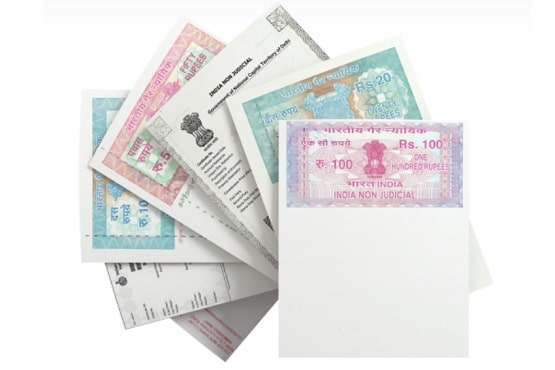One of the most crucial documents when dealing with something legally is stamp paper. Things are official once information reaches the stamp paper and receives approval from government personnel. Judicial (court fee) stamp and non-judicial stamp papers are the two types of stamp paper available. The court fees are paid with the judicial stamp documents. The government sells non-judicial stamp papers via stamp dealers. The Registration Department is in charge of them.
How to Check Authenticity of Stamp Paper?

To secure the legitimacy of significant papers and agreements, it is imperative to verify the authenticity of a stamp paper. Stamp papers are frequently used for a variety of legal purposes, including rental agreements, affidavits, and real estate transactions. Counterfeit stamp papers might result in legal issues and financial losses.
This is how to determine whether a piece of stamp paper is original or fake:
1. Emblem Verification
A stamp paper’s distinguishing characteristics, such as the Ashoka Pillar and the four-headed lion emblem bearing the phrases “India Non-Judicial” in English and the Hindi words “Satyameva Jayathe,” can be used to determine its authenticity. Parallel to the stamp paper, it additionally carries the security code and watermark. When transparent tracing paper is positioned on the stamp paper, the watermark will be visible.
2. Seal and Licence Number
The stamp vendor has a responsibility to stamp his seal, buyer’s name, license number, serial number, year of appointment, and location. The security press at Hyderabad and Nasik prints stamp papers in values ranging from Rs. 10 to Rs. 25,000. In the sale of properties, imprinted stamps or adhesive stamps are employed. In addition to being engraved on stamp paper, stamps embossed, impressed stamps also comprise labels applied and impressed by government-authorized officers.
3. Examine the Paper Quality
Genuine stamp papers are usually composed of superior paper. Verify the paper’s feel by examining its thickness, texture, and general feel. Genuine stamp paper ought to feel solid and resist tearing.
4. Watermark
Watermarks are frequently used by governments to identify their stamp papers. You should be able to see a slight watermark if you hold the stamp paper up to the light. It might be something that stands out against the light, such as a pattern, writing, or a logo.
5. Security Thread
A security thread is incorporated in some stamp papers. Check to see if there is a fine, embedded thread by tilting the paper at various angles. This thread could show up as a line or as a collection of dots.
6. Invisible Ink
For increased protection, certain stamp papers employ invisible ink. To see if there are any patterns or marks buried on the paper, shine an ultraviolet (UV) light over it. Genuine stamp papers frequently have distinctive UV characteristics that are challenging to imitate.
7. Print Quality
Examine the text and graphics that are printed on the stamp paper. Genuine stamp papers often have printing that is crisp, distinct, and well-defined. The printing on fake papers could be smudged or off-centre.
8. Look for Foil Stamps or Holograms
As anti-counterfeiting safeguards, some nations use holograms or foil stamps. Keep an eye out for these components, which are typically glossy and exhibit visual changes when tilted.
9. Serial Number and Barcode
Genuine stamp papers frequently feature a barcode and a serial number. Check to see if the serial number corresponds with the issuing authority’s official records. All stamp papers are required by law to have a serial number on them. The serial number, buyer’s name, date, and address have been added to the stamp sheets along with the vendor’s legally valid signatures.
10. Verify with Issuing Authority
When in doubt, get in touch with the government or the issuing body to double-check the stamp paper’s legitimacy. They might have telephone hotlines or online resources to help you.
11. Compare with Samples
To compare, if at all feasible, get a sample of real stamp paper from a reliable source. You can use this to spot differences in the paper’s watermarks, quality, and security components.
12. Consult Legal professionals:
For advice, speak with a legal professional or an attorney if you believe a stamp paper to be false. They can offer guidance on how to move forward and whether the relevant material can be used legally.
13. Microprinting
Genuine stamp materials frequently have microprinting, which is minuscule text or designs that are challenging to effectively reproduce with conventional printing techniques. Look closely at the stamp paper using a magnifying glass to check for any microprinted details. Microprinting on fake stamp materials may be hazy or difficult to read.
14. Authentication with Mobile Apps or Online Tools
You can check the legitimacy of stamp papers using mobile apps or online resources in some nations and regions. To determine whether the document is authentic, these tools might employ QR codes or other scanning techniques. Find out if there are any similar resources in your area and use them for additional validation.
How to tell if stamp paper is genuine or fraudulent is as follows:
- Visit SHCIL e-Stamp’s official website.
- Go to the ‘Verify e-Stamp Certificate’ page.
- the state, the type of stamp duty, the certificate number, the date the certificate was issued, and a six-character alphanumeric string.
- If your stamp paper is legitimate, you will see the message “Verify Certificate – The following stamp certificate has been found.” Additionally, you will learn the status of the certificate and the date the stamp paper was produced.
- To verify the validity of your stamp paper, you may also scan the barcode on it.
- A different option would be to confirm it with a legal professional.
Conclusion
Keep in mind that using or producing counterfeit stamp papers is prohibited and can result in serious fines. When handling crucial legal documents, use caution and diligence at all times, and take the required measures to verify their legitimacy.
Related Topics:
- How To Check Double Bed Room Application Status Complete Guide
- How to Check Arms Licence Status Online?
- How To Get Citizenship Certificate in India

Santosh Kumar is an editor at unfoldstuffs.com and a professional content writer. With years of experience he is passionate for creating engaging, informative and impactful topics.









